Spirits must be high at Multnomah County’s transportation offices this week. Not only are they finally breaking ground on the Sellwood Bridge project, they also announced Tuesday that they received $17.7 million from the U.S. Department of Transportation’s TIGER program for the final piece of funding needed to replace the bridge.
To celebrate, there’s a big event planned for Friday morning at 10:00 am at Sellwood Riverfront Park. In addition to a slew of regional electeds like Portland Mayor Sams Adams, County Chair Jeff Kogen, County Commissioner Deborah Kafoury, and others, the U.S. Department of Transportation Undersecretary Polly Trottenberg will also be there.
Work is set to begin on the $268 million project this month with in-water construction on the detour bridge (which will have similar bike access as the current bridge) that will be built in order to allow crews to work unfettered on the main bridge (more on the detour here). Work on the new bridge is slated to begin in July 2012 and by the end of 2015, we’ll all be rolling and walking over a much-improved Sellwood span.
In case you haven’t followed this project, you’ll be happy to know that the new bridge will have much better bike access than the current one (which, doesn’t really have bike access at all). The TIGER grant award (which essentially fills the hole left because Clackamas County voters rejected paying their share of the project) means that bicycling improvements are no longer under threat of being budgeted out.
Here’s what the latest designs call for…
At its narrowest point, the new Sellwood Bridge will have a 64-foot wide cross-section with 37 feet dedicated to bicycling and walking (two 12 1/2 foot shared paths and two 6 1/2 foot bike lanes) and 24 feet for cars and trucks (two 12 foot lanes)… (The cross section widens and includes more space for cars and trucks as it approaches the western interchange.)
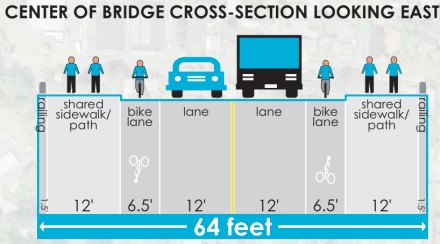
The 12 1/2 foot wide shared path will be similar (but a bit wider) to the Hawthorne Bridge. The county is expected to use the same pavement markings to help separate bikers and walkers. The bike lane itself will be colored green its entire length…

Other bike highlights include new ramps alongside OR 43 on the west side of the bridge that will connect to existing paths (dark green is bike paths)…
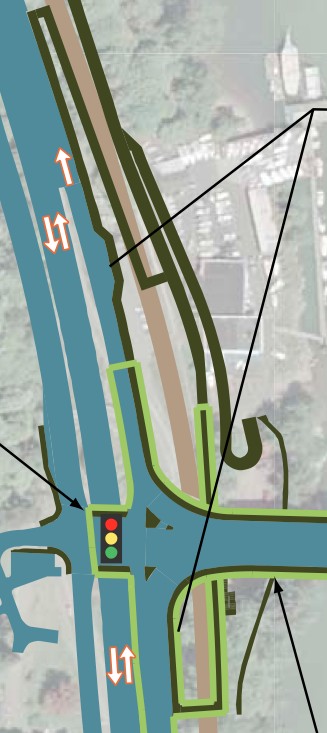
And on the east end of the new bridge, the project will come with a “Bicyclist/pedestrian-activated crossing signal” at SE 6th and Tacoma…
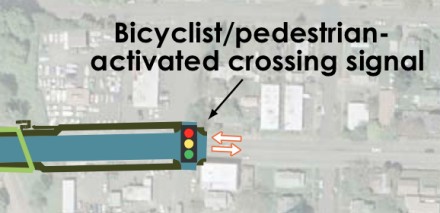
How the bridge interfaces with the dense residential neighborhood on the east side of the river has been a key design consideration. As part of the project’s “2 Percent For Art” budget (the same program that TriMet considered for the sonic bike path idea on their new light rail bridge), the neighborhood is working with the City of Portland and the Regional Arts and Culture Council to develop a “gateway feature”…

The idea behind the gateway is to make it clear to people driving eastbound on the bridge that they are coming into a neighborhood and that they are no longer on a highway. In the words of County spokesman Mike Pullen, the gateway should help people remember that they should “drive appropriately”.
“They see it as not just a landmark,” says Pullen, “but also as a potential safety feature.”
Another exciting aspect of the design if you’re biking or walking across are the four belvederes planned (two on each side). The belvederes will bulb out from the path and offer plenty of room to stop pedaling and take in the view (or take a phone call). There will also be a seating area with a bench…

In times like these, moving forward on a $286 million transportation project that looks like it will vastly improve bicycling is indeed something to celebrate. I don’t blame Multnomah County for including a full “water cannon salute from the Portland fireboat Campbell” to cap off the celebration. See you on Friday!
— Learn more about the project at SellwoodBridge.org.


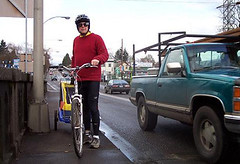
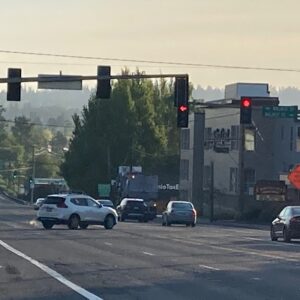
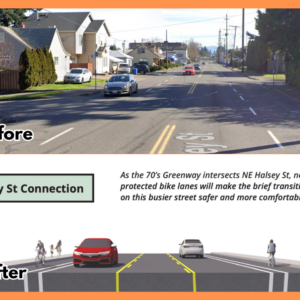


Thanks for reading.
BikePortland has served this community with independent community journalism since 2005. We rely on subscriptions from readers like you to survive. Your financial support is vital in keeping this valuable resource alive and well.
Please subscribe today to strengthen and expand our work.
Seems to me the bike path should be raised up to the pedestrian path just like the Hawthorne. It gives Bikers & Peds a LOT more flexibility, and it gives cars a little less freak-out when they pass bikers.
the raised section is multi-use. a cyclist who does not want to be on the deck can ride on the MUP
I agree about the separation and elevation. Any small cue to reduce tensions and confusion is a good thing.
Ah, but see the lack of a curb between the faster bike lane and the slower and more random MUP basically makes the bike lane part of the MUP.
This is fine if you want to weave slowly in and about pedestrians staggering like drunks.
If you want to go somewhere fast, like say across the bridge, the bike lane has to be kept free of pedestrians.
If a bike lane has to feel “a little bit dangerous” to keep pedestrians off of it I am 100% for it.
The MUP is provided for cyclists who want to go slow or are timid; don’t try to ruin the bike lane for the rest of us.
I think having two bike lanes and a narrower walk would have accomplished the same thing while being more flexible for passing, like what is done on the Hawthorne Bridge.
the drawings i am looking at show a green bike lane on the bridge deck and a raised MUP with designated lanes for bikes over here and peds over there. no one is forcing a cyclist to share the MUP with peds, just get on the deck.
1st comment:
Normally I’d agree on principal but I think we all know that lines on a wide sidewalk does not make a MUP a safe place to ride a bicycle any faster than 5 MPH. To support this supposition I’ll just point to the Hawthorne Bridge path.
Story after story here and even on the Oregonian draws attention to the simple fact that pedestrians go where they want, when they want and however they want.
Common Law backs up the behavior of pedestrians in most circumstances; group psychology and anthropology describe the futility of controlling walking routes.
Raising the bike lane to the same level as the MUP makes it feel as safe as the MUP
I’m also with the idea of there being a deck level bike lane grade separated from the MUP. I noticed, scrolling down the comments, that Spiffy and JAT in Seattle, gave it thumbs up as well.
People new to reading bikeportland, or that have forgotten about them might do a search of the archives for some background on issues the Hawthorne Bridge MUP has had with congestion problems affecting foot and bike traffic. People on bikes on the Hawthorne that want to move fast, but can’t really because of the MUP being thick with people on foot and people traveling slow on their bikes, are going to love this new bridges deck level bike lane.
I would be curious to see what would happen if the bike lane was left at auto deck level but Jersey barriers were added between the bike lane and auto lane.
Being as it is a bridge there is no need for cyclists to make any turns or lane crossings so a physical barrier for separation would not directly detract from cyclist utility.
I am curious if fear of autos is in fact the main factor in keeping most pedestrians out of on street bike lanes.
Too much of this is nebulous alchemy because our society’s behavioral norms don’t allow direct application of European bike amenities, at least not successfully.
There’d have to be good enforcement of the centerline. The center span of the Glenn Jackson Bridge is something of a deathtrap due to the speeds, relatively narrow lanes and tendency for people to ride on the wrong side so they can talk to another rider on what has got to be the noisiest cycleway in the tri-state area.
Dividing the main deck of the bridge with Jersey barriers or plastic bollards as Maus suggested in a comment below, creates a maintenance problem; all the main lane junk that gets cast into the 6.5′ bike lane that a regular street sweeper probably can’t access.
re; fear of autos possibly being the reason that keeps people from deciding to ride bikes even though their route has bike lanes.
I phrased that, thinking it’s what you might have meant. Let’s say: people of middle age that may not have ridden a bike since they were a kid, but managed to always have jobs that enabled them to use a car for every conceivable travel need…a description I think represents many, many U.S. citizens.
After all that time away from bikes, to the minds and bodies of people like these, bikes are alien devices. Besides the maintenance issues and that there just probably wouldn’t be room on the bridge for the bigger, wider Jersey barriers, I don’t see that barriers dividing the main travel lane from the bike lane would encourage more of this type person to decide to ride.
The deck level bike lane will likely be the fast track for people on bikes. Person commenting to this story, ‘nuovorecord’, says speed limit across the bridge is 30mph:
http://bikeportland.org/2011/12/15/cue-the-water-cannons-sellwood-bridge-breaks-ground-friday-63834#comment-2316043
For starters, reduce that speed limit to 25mph (which creates an effective 30mph). Second, post speed limits for the bike lane half of the MUP, at the entrance to the MUP…say 7-10 mph…giving bridge users advance notice to enable them to choose which bike lane is best for them.
Odds are, the ‘long away from riding’ type of person, and less aggressive riders are going to take the MUP option.
“don’t try to ruin the bike lane for the rest of us.”
I’m sorry if it ruins your bike experience to stay to the far end of a lane while still going the speed you want. My feelings are that as a driver I don’t want to freak out every time I pass a biker on a very narrow bridge. Apparently it ruins your biker “experience” to share with peds and not cars. Interesting.
Drive in a sensible manner and there is no need to freak out – do you swerve all over the place while trying to talk on your phone or something?
“…My feelings are that as a driver I don’t want to freak out every time I pass a biker on a very narrow bridge. …” Name
Hold off on the Valium! One of the diagrams accompanying this story shows the motor vehicle lanes to be 12′ wide each, a standard width motor vehicle lane. With it’s own 6’5′ width lanes…generous by standard bike lane widths, bike traffic will have a good, strong 3′-5′, maybe slightly more between it and motor vehicles traveling in the main lanes, assuming people on bikes travel single file and down the center of the bike lane.
Prepare to freak out.
If the on street bike lane is raised to the same level as the sidewalk it will be encroached upon by users whose paths resemble that of drunken butterflies; much in the same manner as pedestrian and noob cyclist behavior on the main portion of the Hawthorne Bridge.
When that happens expect us vehicular cyclists to be on the road deck.
Legally.
Why not lower the path bike lane to street level, and post a “keep right except to pass” or “slower traffic keep right” sign?
The bike lane needs to be on the same level for emergency parking.
If you break down, better make it to someplace you can get yourself clear of all travel lanes. Bike lanes are travel lanes, not a place to break down.
Rare is the road and especially rare the bridge that has a lane the width of a car designed for “breaking down”. It happens where it happens, which is what differentiates it from “pulling over to check the tires”, or similar.
Study this diagram again, closely:
http://bikeportland.org/wp-content/uploads/2011/12/sellwoodcross.jpg
That diagram shows that on the deck, plenty of room has been provided for both motor vehicles and bikes. Motor vehicles have their own 12′ lanes to travel in…bikes have their own 6.5′ lane to travel in.
This is comparable to a typical neighborhood street in which the street parking has been exchanged for a bike lane, as was done out in Beaverton with Lombard St which I’m fairly certain, has 12′ lanes. I’m not feeling motivated enough at the moment to go search out the existing Sellwood bridge lane widths, but I’m thinking its lanes may be slightly narrower than 12’…(maybe 11′ or even 10.5′ ?), because when I’ve driven the bridge, cars passing from the opposite direction seemed kind of close.
Jonathan,
My understanding is that they’re actually pushing the current bridge span north onto the new piers (just the middle portion, where the girders aren’t cracked). That means there won’t be any new bike facilities on the detour bridge, at least not in the middle portion.
See here for details:
http://www.sellwoodbridge.org/?e=36
http://tomdwyer.com/2011/uncategorized/sellwood-bridge-update-youll-never-believe-this%E2%80%A6/?PHPSESSID=d2a895eb6dae049e91c0c5058fed8c5d
won’t be worse than it is now
Jeeez, My thoughts exactly!!! All this whacked out criticism and speculation! I would rather walk on a rope bridge, than ride my bike across the current Sellwood bridge!! I am surprised this got any traction for funding in the first place.
grumpcyclist is right about the detour, but the best link on the Sellwood Bridge website to understand what will happen with the detour is at:
http://www.sellwoodbridge.org/?p=detour-bridge-approach2
Wouldn’t it be cheaper and easier to just close the bridge to motorized traffic and call it good? It’s not like we don’t have a brazillion other bridges on the Lower Willamette, it’s the most-spanned body of water in the world.
The main problem with the Sellwood is related to land movements on the west (cemetery) side that will eventually undermine the footings. Closing it to cars won’t stop it from falling down.
The “most-spanned body of water in the world.” Was this intended as a joke or are you serious?
The first river that came to mind was the Chicago River. In approximately two miles (Harrison Street to Lake Michigan) there are twenty (20) river crossings. Surely, that is more spans than there are bridges over the Willamette between the Columbia River and the south edge of the Portland metro area.
Maybe a “bazillion” is less than 20?
The word he used was actually “Brazillion”, meaning the other bridges have free coffee sometimes. 😉
I thought he meant a bridge free of hair below.
Ah! That’s what those “men working below” signs are all about!
I know there would be a lot of car drivers seriously put out about this. How about keeping the old bridge as a pedestrian and cycle bridge and build the new one as a car only bridge along side? Just my 2 cents.
See Paul Souders comment above about the bridge falling down. I don’t want that worn out thing as my dedicated MUP. Otherwise not a bad idea.
Cost. The old bridge would still need to be maintained with increased regularity as it ages, even with the reduced loading. A new bridge would still require sidewalks for emergency egress so would not be much cheaper than the proposed option. A bike/ped only bridge across the Willamette River would be highly cool though…
Awesome! Not only will it improve cycling and pedestrian access/safety but also create good paying, family wage jobs in the construction of it……a win, win all round.
The bummer part about highway construction jobs is that the jobs are gone after the construction is over. It’s not like a busway or a railroad where you have drivers and frequent preventative maintenance. This is something that, once built, will go untouched until its unable to handle it’s designed-for purpose once again.
1. This is a replacement, not an additional facility, line, service, et cetera. Not like there’s that kind of option for this need.
2. You are incorrect in assuming that bridges don’t require regular maintenance. Concrete and steel, they still have many parts that move and wear, plus they need all the maintenance that any other road does.
3. Rail is massively subsidized (not profitable), so all of those jobs, while ongoing, require ongoing subsidy by taxpayers.
i love this so much!
This week the construction company closed off access to the south end of the railroad tracks between Staff Jennings and the Macadam Bay drive. (Also to the hiking path under the tracks and along the river south of the bridge.) So if you’re used to taking the shortcut along the tracks (and bypassing the crazy narrow sidewalk “chute” below Macadam) … that shortcut isn’t available any more.
I also used to take the dirt path under the bridge from the cemetery, and a worker told me they’d be closing off access to the underside of the bridge.
I can’t imagine the shoo-fly bridge will be any worse than what exists now (i.e. Take the Lane), unless they ban bikes from it altogether.
Hooray!!!
No more death-defying trips across the Sellwood Bridge. Families with children will be abel to get across safely If you think the present bridge is dangerous for one adult cyclist, you should have tried it with a child
I’ve been cycling on this bridge for over 12 years now and I’m very, very excited that we’ll soon have something far superior. I’m also very grateful to the core group of people who fought hard for years to ensure that this is a bike and pedestrian friendly bridge: Richard Marantz, Heather Kock, Eric Miller, and a bunch of others. We all owe you a beer or three!
Do we really need a bike lane and a bike path? Regardless, excited to see this moving forward!
If I hear you right, dsaxena, you’re wondering about 1 lane for cars (per direction), 1 for peds, and 2 for bikes. If I got you right, it does seem like possible overkill, but also makes this project seem more like the ultimate Anti-CRC. Which is to say, make the structure more sound, maintain capacity for autos, and greatly increase capacity for active modes. Some vocal opponents of this design (when opposition still had an opportunity) said “screw bikes, we need more car lanes”. That the design may err in the opposite direction is refreshing to me.
I’d say on bridge with only one lane in either direction, yes – as you remove a situation where a driver can become frustrated or impatient because they feel they are being held up by a “slow cyclist”, and faster cyclists can take the deck-level lane rather than the path shared with walkers.
On a bridge with two lanes per direction, such as the St. Johns, I don’t think it’s as big of an issue. I’ll take the right lane there and haven’t had any issues because folks can just go around me, and walkers still have the sidewalk. However, I don’t particularly enjoy the Sellwood bridge as it is now, and will be glad to see it made into a less stressful crossing in the future.
I think it’s great because I can putter along slowly on the shared path while the lycra warriors zip past on the road-level bike lane…
Exactly! or put another way… the people who are trying to get someplace as quickly as is feasible given their mode choice can use the road level bike lane while wobbly putterers can poodle along with the pedestrians.
no need to cast aspersions – it’s win-win!
This. There’s a lot more disparity between pedestrian’s and cyclist’s speeds, than that of autos and trucks. Someone riding at 20 mph is twice as fast as someone riding at 10 mph, and nearly 7 times as fast as someone walking at 3 mph. So two bike lanes are warranted, in my view. There will be a lot of people stopping to enjoy the views, both on bike and foot, as well they should! But people who are just wanting to get from Point A to B as quickly as possible will be able to safely do so. And without slowing autos down. It’s a win-win-win situation.
True, but why not put them at the same level? Putting a curb between the two effectively makes it a no-lane-change zone by way of physical barrier.
“…Putting a curb between the two effectively makes it a no-lane-change zone by way of physical barrier. …” Paul Johnson
What need for a lane change are you thinking of? People riding bikes on the MUP wanting to merge into the deck bike lane to pick up the pace? Time involved in crossing the bridge even at a walking pace isn’t very long. 10 minutes, maybe a little more.
People wanting to hop from the deck bike lane to the MUP to take a gander over the railing at the river? There will probably be some of that, but I wouldn’t think a lot. Anyway…hope not.
With the grade separated deck level bike lane, some of the people riding bikes are apt to be traveling 20-30mph. They probably couldn’t do that on the MUP, because that rate of speed on the same grade as the MUP, right next to people on bikes traveling 7-10mph could be serious trouble.
By the way, I’m trying to remember what the speed limit across the Sellwood Bridge is.
That was my thinking, too. Maybe a few strategically placed curb cuts could be a compromise solution?
Speed limit on the bridge is 30 mph.
By the usual rules of the road, you stay right except to pass. This forces you to decide if you’re going to pass at the start of the bridge, and more or less makes passing illegal if you picked the MUP to start with, and forces you to take the general purpose lane to pass someone if you picked the main roadway.
As an inner Clackamas county resident who voted FOR funding the bridge, is there a Portland/Multnomah County bike infrastructure charity that I can send an end-of-year donation to, in order to express my gratitude and support for this project?
2015 is shaping up to be a banner year for Portland bridges. Isn’t that the same year that the Portland-Milwaukie LIght Rail bridge is supposed to open?
I like the “MUP + bike lane” design.
It’s gorgeous. I love it.
Is it just me, or does it seem like the two 6.5′ bike lanes were designed to allow the addition of a 3rd vehicle or transit lane at some point in the future?
I can see it:
“Due to low utilization, the bike lanes will be converted to transit/HOV/Streetcar lanes. Cyclists can now use the existing 6′ sidewalk bike lanes”
On a bridge, what would the benefit of a third motor vehicle lane be? It can’t serve as a turn lane. Shouldn’t be used as a passing lane. An alternating direction streetcar? I guess I don’t see likely reasons the deck bike lanes could possibly be scrapped at some point for motor vehicle use.
The Sellwood bridge can get very congested during rush hour. If they extend the streetcar into Sellwood, the logical move for them would be to add a bi-directional streetcar track down the middle, to bypass the traffic.
It pisses me off the Clackamas County isn’t helping pay for a bridge that’s 1 mile from the county line and they are the biggest user. It’s time for a Clackamas County only toll! I live here and rarely use the bridge, but support paying for it, for the good of the metro area.
I, for one, wouldn’t mind one bit if everyone was tolled to pay for the new bridge. It’s not like the Creek Turnpike Cycleway wasn’t paid off using tolls, and it’s not like Kansas doesn’t already have successful long-distance toll cycleways. Just charge $1.50 for multiple axles, 75 cents a car and a quarter a bike…
Excellent! I’m wondering how this will connect to bike/ped infrastructure on the west side, since it is practically non-existent.
Well, you can go up through the cemetery to Terwilliger, or go north past the old Staff Jennings complex to the “cycle path” along the water and into downtown through the south waterfront.
Those are two options right there.
I’m very excited about the new bridge. I would disagree with the characterization that the existing one lacks bike access. I do ride the Sellwood once every couple weeks or so, although I sure don’t enjoy it much and I will NOT take my child on it.
I think the new lane configuration is just right. Plenty of width in both the car and bike lanes, and the faster riders will be off the MUP. Perfect. Congestion and conflict between pedestrians and riders of different speeds have become a serious problem on the Hawthorne.
Of course I’d love to see a similar solution on the Hawthorne, with the outer lanes on the deck converted to bike-only use. If bike trips on the Hawth keep going up and car trips keep going down (excluding the recent spike due to the Morrison closure) maybe we’ll see that happen someday.
I love how the pedestrian in the drawing looks confused.. wondering to himself why he has so little space and the bikes have two lanes.
I’m all for multiple bikeways, especially those for the interested-but-concerned crowd, but there is something altogether strange with this configuration. Why not raise the entire bikeway up to sidewalk level and have two lanes there? It gives credence to the idea that they’d like to eventually add another lane at some point and they can say the bike lanes are redundant.
Steve,
The thing with the bike lanes is that the space is also meant as a shoulder to accomodate break-downs and emergency vehicles. I think it should at the least have some plastic bollards to help separate it… and I think that might actually happen in certain segments.
And I dare someone to try and make that space a standard car lane someday… not gonna’ happen.
This shows the new mantra of choice in bike planning. Just like you see with Hawthorne/Clay, and how PBOT director Tom Miller talks about Multnomah/Holladay. The idea is to acknowledge that people who bike have wide varieties of preferences and when possible it makes sense to allow people to self-select which type of experience they prefer.
As for the “pedestrian in the drawing”… I think it makes total sense for bike traffic to have more space. Bikes travel faster than people on foot and they have a larger vehicle footprint, so they require more space.
If it was meant as a breakdown lane, it wouldn’t have reserved travel lane markings. Bike lanes are no different from HOV or transit lanes in this regard: You can’t leave your car there.
Good to hear other perspectives on this. I’m happy to wait and see it built before I pass judgment, but I’m sensitive to these “shared pathway” installations. It hasn’t worked well for our MUPs. Without the need for a breakdown/emergency vehicle lane, that space could be configured so both bikes and peds would enjoy their very own unadulterated space.
Someone in a BP comment somewhere coined the term “Hawthorne stress fest”. While these sidewalks are 2ft wider than Hawthorne’s 10ft sidewalks, I fear another shared sidewalk configuration will make it an uncomfortable environment for people walking. I would love to be proven wrong on this and so we’ll just have to wait and see it in action.
Anyway, enough skepticism from me. This is a terrific improvement over the “Sellwood Life-in-the-hands-of-the-road-rager-behind-you fest” we enjoy today.
Another helpful thing about there being a bike lane on the deck as well as a slower provision for bike use on the elevated MUP, is that…hoping no one will…if someone should happen to ride off the MUP onto the deck, they won’t be falling directly into the main lane used by motor vehicles.
Related question, is how high the elevated MUP will be above the deck. The MUP on the Hawthorne is up a bunch…higher than a regular street curb, which I suppose is about 4″. So…maybe 6″. Dropping unexpectedly off that thing wouldn’t be good.
Does anyone know if the bike lane will have a slight raise to it (I’m thinking like the way the cycle track on NE Cully is) so that it can still serve as car-accessible for “emergency parking” but still serve as a deterrent for at-speed motor vehicles from every veering into it?